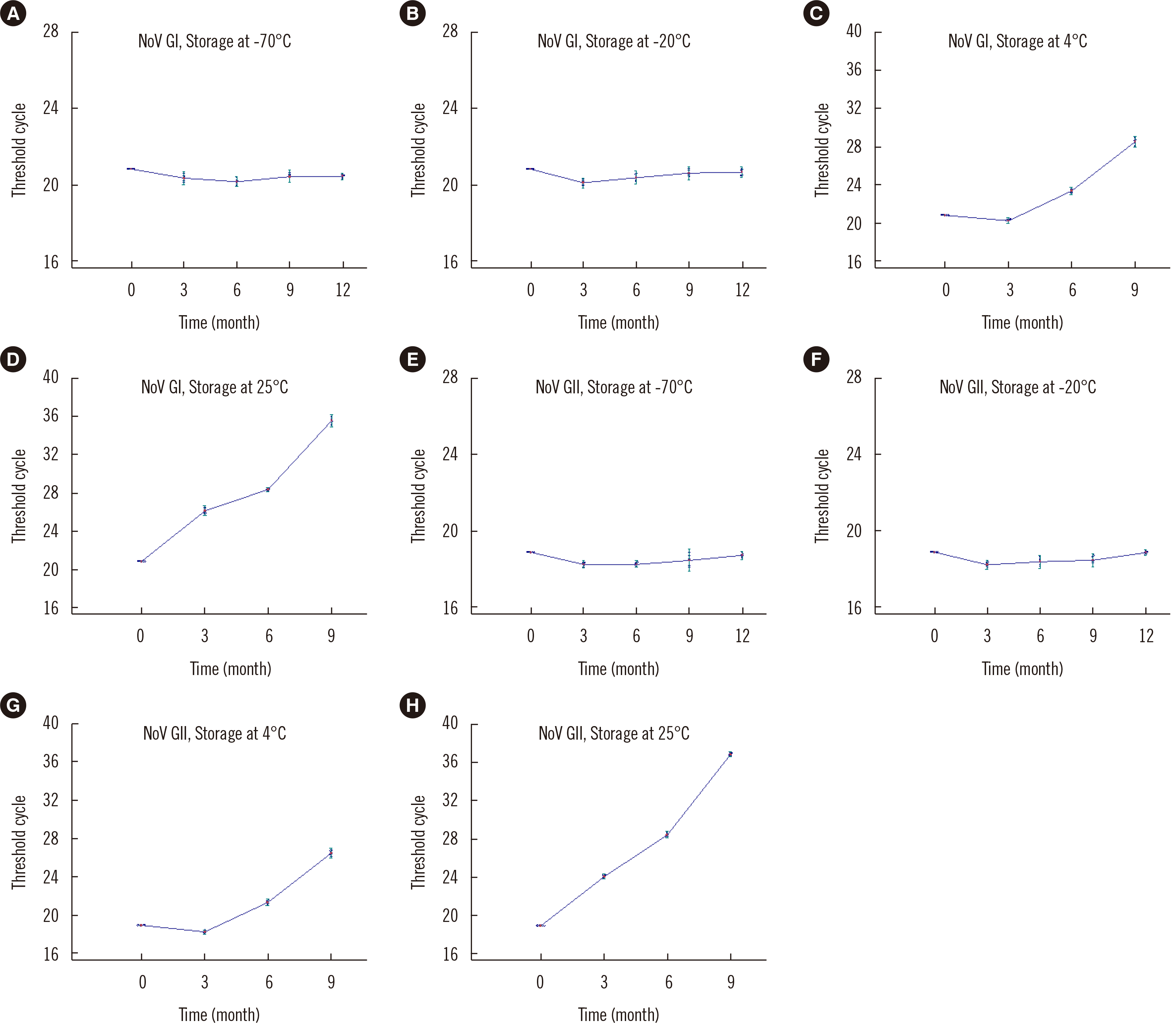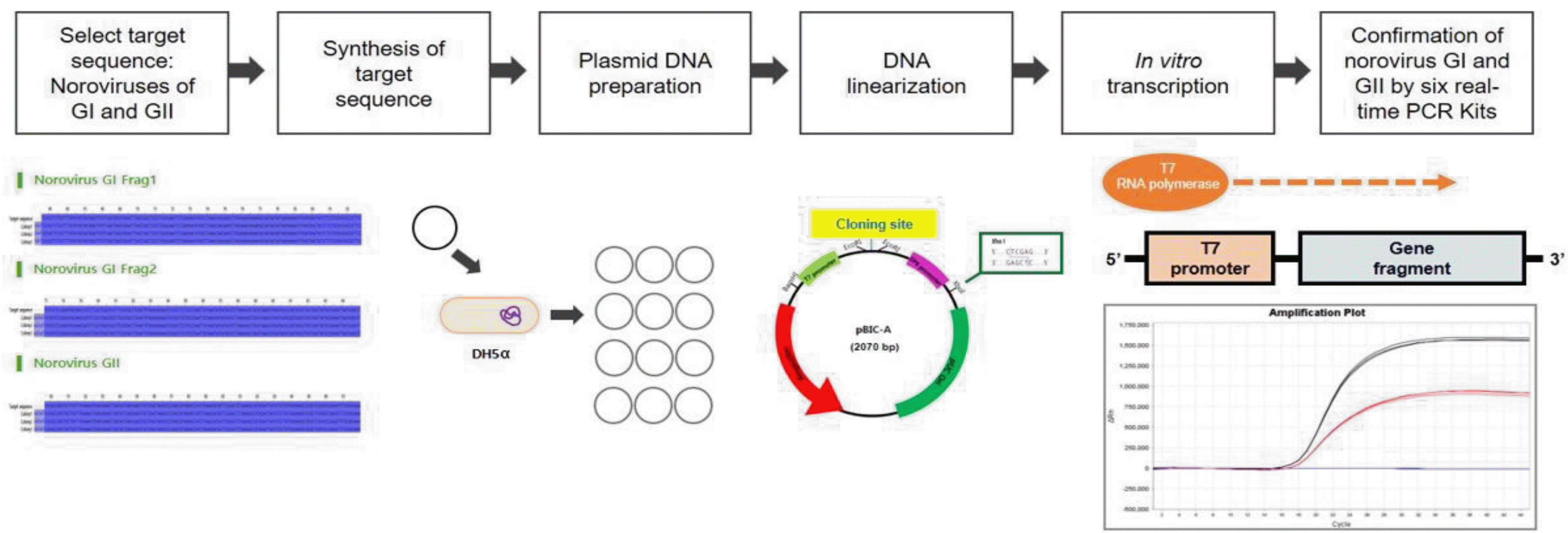2. Jiang X, Wang M, Wang K, Estes MK. 1993; Sequence and genomic organization of Norwalk virus. Virology. 195:51–61. DOI:
10.1006/viro.1993.1345. PMID:
8391187.

3. Chhabra P, de Graaf M, Parra GI, Chan MC, Green K, Martella V, et al. 2019; Updated classification of norovirus genogroups and genotypes. J Gen Virol. 100:1393–406. DOI:
10.1099/jgv.0.001318. PMID:
31483239. PMCID:
PMC7011714.

4. Chhabra P, Graaf M, Parra GI, Chan MC, Green K, Martella V, et al. 2020; Corrigendum: Updated classification of norovirus genogroups and genotypes. J Gen Virol. 101:893. DOI:
10.1099/jgv.0.001475. PMID:
32854814. PMCID:
PMC7641392.

5. Burke RM, Mattison CP, Pindyck T, Dahl RM, Rudd J, Bi D, et al. Burden of norovirus in the United States, as estimated based on administrative data: updates for medically attended illness and mortality, 2001-2015. Clin Infect Dis. 2021; 73:e1–8. DOI:
10.1093/cid/ciaa438. PMID:
32291450. PMCID:
PMC8112883.

6. Zhang L, Sun Y, Chang L, Jia T, Wang G, Zhang R, et al. 2015; A novel method to produce armored double-stranded DNA by encapsulation of MS2 viral capsids. Appl Microbiol Biotechnol. 99:7047–57. DOI:
10.1007/s00253-015-6664-4. PMID:
25981999. PMCID:
PMC7079959.

7. Yang YC, Shih DYC, Tsai MH, Cheng CH, Cheng HF, Lo CF, et al. 2013; A collaborative study to establish the first National Standard for HIV-1 RNA nucleic acid amplification techniques (NAT) in Taiwan. J Virol Methods. 191:122–7. DOI:
10.1016/j.jviromet.2013.04.002. PMID:
23608407.

8. Fryer JF, Heath AB, Minor PD. Collaborative Study Group. 2016; A collaborative study to establish the 1st WHO International Standard for human cytomegalovirus for nucleic acid amplification technology. Biologicals. 44:242–51. DOI:
10.1016/j.biologicals.2016.04.005. PMID:
27179913.
9. Saldanha J. 2001; Validation and standardisation of nucleic acid amplification technology (NAT) assays for the detection of viral contamination of blood and blood products. J Clin Virol. 20:7–13. DOI:
10.1016/S1386-6532(00)00149-9. PMID:
11163577.

10. Mattiuzzo G, Ashall J, Doris KS, MacLellan-Gibson K, Nicolson C, Wilkinson DE, et al. 2015; Development of lentivirus-based reference materials for Ebola virus nucleic acid amplification technology-based assays. PLoS One. 10:e0142751. DOI:
10.1371/journal.pone.0142751. PMID:
26562415. PMCID:
PMC4642882.

11. Pasloske BL, Walkerpeach CR, Obermoeller RD, Winkler M, DuBois DB. 1998; Armored RNA technology for production of ribonuclease-resistant viral RNA controls and standards. J Clin Microbiol. 36:3590–4. DOI:
10.1128/JCM.36.12.3590-3594.1998. PMID:
9817878. PMCID:
PMC105245.

12. Bettonville V, Nicol JTJ, Furst T, Thelen N, Piel G, Thiry M, et al. 2017; Quantitation and biospecific identification of virus-like particles of human papillomavirus by capillary electrophoresis. Talanta. 175:325–30. DOI:
10.1016/j.talanta.2017.07.046. PMID:
28841998.

13. Venereo-Sanchez A, Simoneau M, Lanthier S, Chahal P, Bourget L, Ansorge S, et al. 2017; Process intensification for high yield production of influenza H1N1 Gag virus-like particles using an inducible HEK-293 stable cell line. Vaccine. 35:4220–8. DOI:
10.1016/j.vaccine.2017.06.024. PMID:
28648546.

14. Cazenave C, Uhlenbeck OC. 1994; RNA template-directed RNA synthesis by T7 RNA polymerase. Proc Natl Acad Sci U S A. 91:6972–6. DOI:
10.1073/pnas.91.15.6972. PMID:
7518923. PMCID:
PMC44320.

16. Schott JW, Morgan M, Galla M, Schambach A. 2016; Viral and synthetic RNA vector technologies and applications. Mol Ther. 24:1513–27. DOI:
10.1038/mt.2016.143. PMID:
27377044. PMCID:
PMC5113109.

17. ISO Guide 35:2017 Reference materials—guidance for characterization and assessment of homogeneity and stability. Geneva: International Organization for Standardization;2017. DOI:
10.1016/j.vaccine.2017.06.024.
18. Prodromou C, Pearl LH. 1992; Recursive PCR: a novel technique for total gene synthesis. Protein Eng. 5:827–9. DOI:
10.1093/protein/5.8.827. PMID:
1287665.

19. Kim HS, Hyun J, Kim JS, Song W, Kang HJ, Lee KM. 2012; Evaluation of the SD Bioline Norovirus rapid immunochromatography test using fecal specimens from Korean gastroenteritis patients. J Virol Methods. 186:94–8. DOI:
10.1016/j.jviromet.2012.08.014. PMID:
22960089. PMCID:
PMC7119779.

20. Yang JH, Lai JP, Douglas SD, Metzger D, Zhu XH, Ho WZ. 2002; Real-time RT-PCR for quantitation of hepatitis C virus RNA. J Virol Methods. 102:119–28. DOI:
10.1016/S0166-0934(02)00007-1. PMID:
11879700.

21. Kim JS, Kim HS, Hyun J, Kim HS, Song W. 2015; Molecular epidemiology of human norovirus in Korea in 2013. Biomed Res Int. 2015:468304. DOI:
10.1155/2015/468304. PMID:
26421289. PMCID:
PMC4572438.

22. Fryer JF, Heath AB, Wilkinson DE, Minor PD. Collaborative Study Group. 2016; A collaborative study to establish the 1st WHO International Standard for Epstein-Barr virus for nucleic acid amplification techniques. Biologicals. 44:423–33. DOI:
10.1016/j.biologicals.2016.04.010. PMID:
27461128.

23. Madej RM, Davis J, Holden MJ, Kwang S, Labourier E, Schneider GJ. 2010; International standards and reference materials for quantitative molecular infectious disease testing. J Mol Diagn. 12:133–43. DOI:
10.2353/jmoldx.2010.090067. PMID:
20075208. PMCID:
PMC2871718.






 PDF
PDF Citation
Citation Print
Print




 XML Download
XML Download